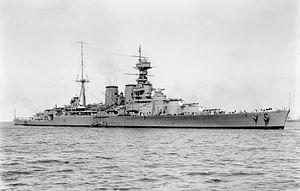The pseudonymous naval historian—whose writings I read and oftentimes enjoy—has hauled the Naval Diplomat into the dock over at Information Dissemination for grave crimes against…something. History with a capital H, I suppose. Or at least against the consensus among the cool kids in the field. The alleged offense: inserting an aside in a recent National Interest essay pronouncing the battlecruiser a failed experiment when used in ways it wasn’t designed for. That’s a cautionary tale of enduring value.
Prithee have a look at both items and hurry back.
Battlecruisers were fleet-footed, heavy-hitting vessels yet were less stoutly armored than their dreadnought brethren—and thus less well-equipped to take a punch from battleships’ main guns. That wasn’t their purpose. They were built to act as skirmishers for the fleet, or to prosecute independent operations in low-threat settings. Either way, they would outgun all comers while boasting sufficient protection to withstand light enemy gunnery. The concept was perfectly sound.
Trouble is, commanders tended to depart from the concept. You get the sense the battle part of the name won out over the cruiser part, which carries very different connotations. As a result, battlecruisers sometimes found themselves steaming in battle lines alongside ponderous yet thickly armored dreadnoughts. That would subject them to a pounding from enemy battleships should the fleet get in a scrap with a peer navy.
Battlecruisers were swift and tough enough to assail enemy fleets’ screens of light combatants, or to run roughshod over enemy cruisers, destroyers, or lighter craft encountered during independent steaming. But if commanders situated them in the battle line—slowing them down to the speed of the slowest ship in the fleet while putting them in range of battleship gunnery—that nullified their chief advantage. And it did so while accenting their chief vulnerability. Accentuating the negative while eliminating the positive is not a winning formula.
That was about the sum total of my battlecruiser-related wisdom over at TNI. Boilerplate, wouldn’t you say? Use the right tool for the job. Now, you’ll notice a couple of things in Lazarus’ little jeremiad that are a mite peculiar. First, the word Jutland appears nowhere in my National Interest piece. It’s a one-paragraph mention of battlecruisers. Indeed, it verges on being a throwaway in a less-than-deadly-serious article that invokes such weighty sources as the sci-fi epic Battlestar Galactica. Yet he drones on and on about the minutiae of that World War I fleet action. (Speaking of which, as long as we’re picking nits, the Battle of Jutland took place in 1916, which by my arithmetic was a shade under a century ago, not “just over 100 years in the past.”)
Nor, secondly, did I claim the problem with battlecruisers was all about side armor, as Lazarus seems to think. It’s about a ship’s innate protection—full stop. Ship designers have to balance among three attributes: speed, protection, and armament. If you want a lot of one or two of these attributes, you end up sacrificing along the other axes. If you want a whole lot of one attribute—say, speed—you end up with the Littoral Combat Ship, a fleet vessel with minimal protection or firepower. And you may end up backtracking on the concept once its failings become obvious.
When designing battlecruisers, then, British naval architects prized speed and armament over protection. Making that tradeoff—doubtless a painful one—let them wring extra speed out of a man-of-war fitted with battleship-caliber guns. Royal Navy battlecruisers were less heavily armored than their dreadnought cousins, both along their sides and on horizontal surfaces like decks and turret roofs.
The latter ended up being the battlecruisers’ main Achilles heel at Jutland, where German gunners rained plunging fire—fire arcing down at steep angles—onto Britain’s Grand Fleet. That’s why British shipbuilders “up-armored” the horizontal surfaces on subsequent battlecruisers, to use the awkward term currently in vogue. In so doing they tacitly conceded the flaws in the design. If the design was vindicated at Jutland, why change it afterward? And why not shed the battleship inventory altogether and go over to an all-battlecruiser fleet?
Now, battlecruisers’ sides also would have been vulnerable to battleship rounds coming in at shallow angles. How well the armored plating, the armored box enclosing the engineering spaces, and other structural features would have stood up was never put to the test of combat. Nor indeed were the other post-Jutland modifications. Jutland was the last major fleet engagement of the Great War, and the last chance to test naval hardware and methods in combat.
Incidentally, the U.S. Navy experimented with its own analogue to the battlecruiser in the form of the “fast battleships,” battlewagons not built to withstand a hit from their own main battery. How the Iowa class would have fared in an American version of the Battle of Jutland will never be known. The age of battleship supremacy passed during World War II, leaving this a subject for debate among naval enthusiasts.
All in all then, Lazarus convincingly refutes something I never said. The battlecruiser experiment illustrates the perils of constructing a ship to fight one way and then using it to fight another. It’s also about the tradeoffs that are inescapable when dreaming up new warship classes. If you build a ship for speed, use it in ways that exploit speed. Don’t build it for speed, then slow it down, handicap its ability to maneuver, and subject it to battering from enemy weaponry it’s not meant to withstand. The same goes for warships’ other attributes. If you sacrifice in one area, you have to work around that deficiency in battle.
Lazarus meanders into a discussion of offensive sea control toward the end of his piece. One suspects he’s not arguing about battlecruisers or historical minutiae at all, but about contemporary American maritime strategy. If so, let’s have that debate. We started off with Stripes; let’s close with Seinfeld. Enough already with arguments about nothing.

































